Yes! I'd like to be contacted to schedule a consultation!
Roofing services are in high demand in your area, but you’re still having some trouble connecting with local home and business owners who are ready to invest in a new roof, repair an existing roofing system, or embark on a reroofing project. Improving your SEO can help.
In this guide, LinkNow Media’s search engine optimization (SEO) specialists explain roofing SEO best practices step-by-step, define its pillars, and show you how to harness its power to put information about your roofing services in front of more people who are actively using their desktops and laptops, mobiles, and tablets to search for roofing solutions.
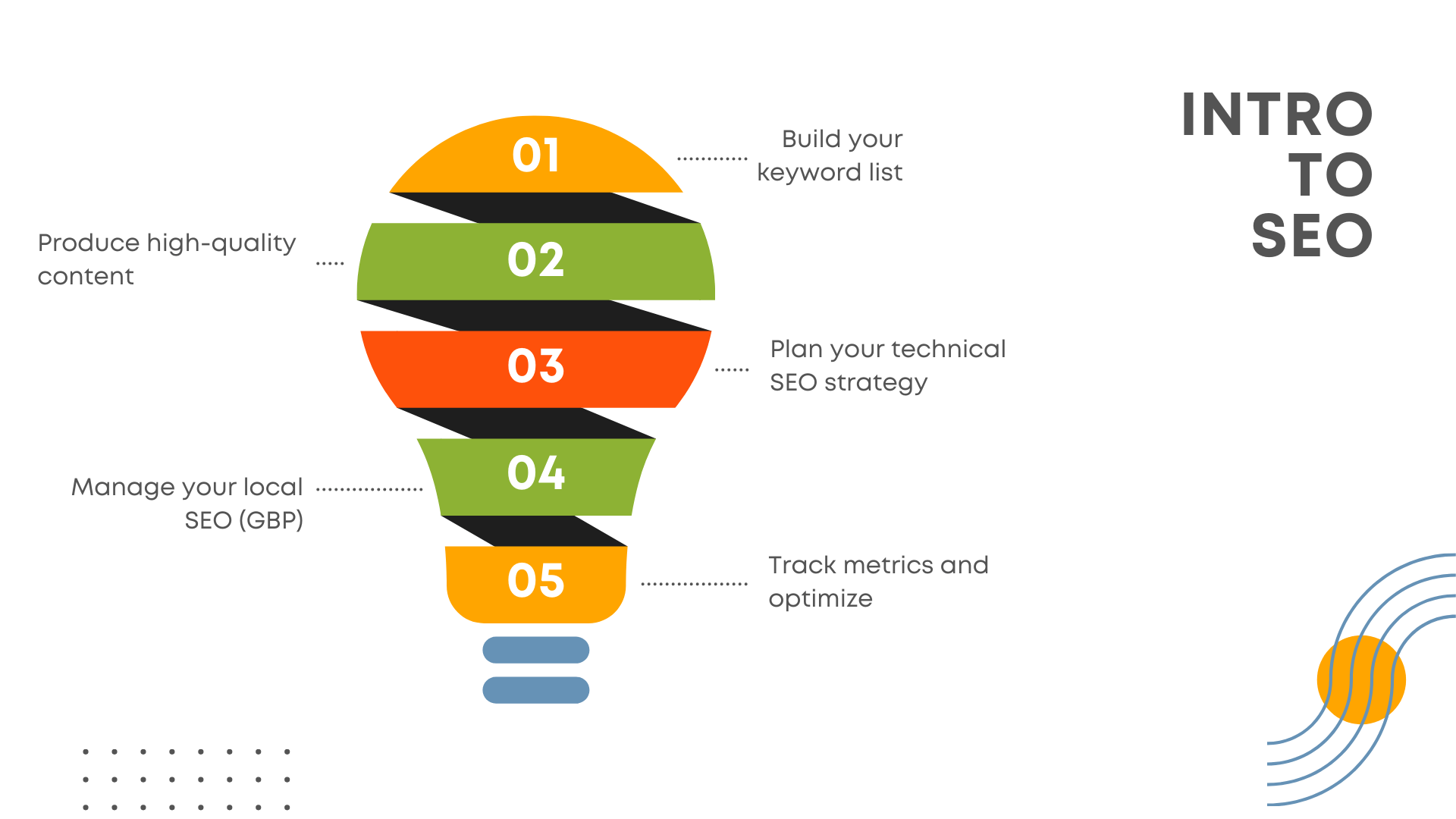
SEO for roofers works by tailoring your roofing company’s online content, website structure, and digital reputation to meet user expectations and search engine algorithms’ criteria for relevance and authority. It starts with selecting the right keywords—terms that potential customers will likely use when searching for your services. These might include phrases like "roofing repair near me" or "commercial roof replacement."
Once you’ve identified these keywords, you strategically integrate them into your website content, meta descriptions, and headers to help search engines understand your roofing site’s focus (we’ll show you how below). Creating high-quality content, like informative blog posts or guides, is another part of SEO that helps you establish authority in the roofing field and gives your site a better chance of ranking.
SEO for roofers also involves optimizing technical elements, like page load speed and mobile compatibility, to improve user experience. Meanwhile, local SEO techniques, like managing your Google Business Profile listing and earning positive reviews, further boost your visibility in your community, making it easier for local customers to find your trusted roofing services when they need them most.
That’s SEO in a nutshell, but it’s a nuanced and evolving field, so we’ve broken it down with step-by-step instructions below. To better understand how it all comes together, you’ll need to know how search engine rankings impact who can see your roofing site in search engine results.
An optimized roofing website is your ticket to gaining traction in major search engines. Since most users don’t look past the first page of results, a rank of anything less will leave your business out in the weeds—no matter how valuable your roofing expertise and services are.
When you use the fundamentals of SEO to create an exceptional user experience, you make it easy for search engines to crawl, index, rank, and display your pages, and you connect your target audience with the information they need to complete their buyer’s journey. It’s a win-win strategy that shows search engines your content is valuable enough to rank favorably, helps you establish industry authority, and helps your business build trust with locals looking to connect with a reputable roofer.
Once you master the pillars of SEO for roofing contractors, your efforts will drive more leads, clicks, emails, and calls, which is what you need to get your foot in the door so you can offer them an upfront roofing estimate and show them what you’re capable of.
Below, you’ll find everything you need to know about SEO for roofing installers, repair experts, maintenance providers, and roof inspectors.
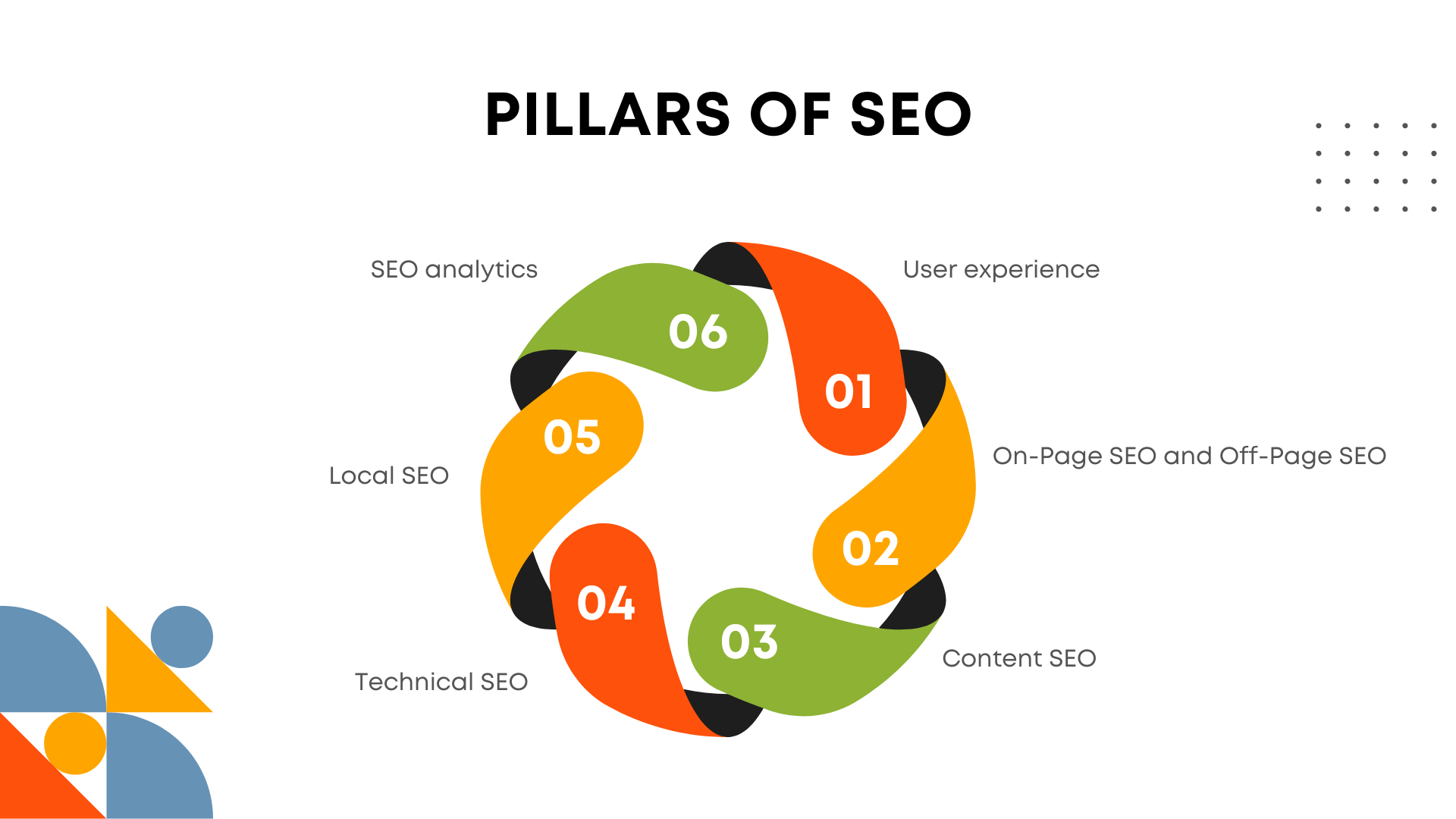
Now that you know what SEO is and how it affects your site rank in search engine results pages (SERPs), you’re ready to learn more about the pillars of search engine optimization for roofing companies. In the following sections, we’ll teach you how to implement a robust optimization strategy that aligns with your goal of bringing more leads to your roofing business.
A strong foundation in roofing SEO includes the following:
Let’s look at each in more detail.
User experience and conversion rate optimization directly impact how visitors engage with your website and whether they decide to contact you. Good UX means your website is easy to navigate, loads quickly, and provides relevant, easily accessible information, making it more likely for visitors to stay on your site. This positive interaction shows search engines that your website holds value, which can boost your rankings.
CRO focuses on converting these visitors into leads, whether by filling out a contact form, requesting a quote, or calling for an inspection. Effective CRO strategies include adding clear calls to action, user-friendly forms, and intuitive design elements that guide visitors toward taking action.
All your SEO initiatives aim to create the best possible user and crawler experience so you can get leads that convert into customers. Together, UX and CRO create an easy, engaging experience that attracts users and encourages them to choose your roofing services. That’s how you maximize your site’s traffic and conversion potential.
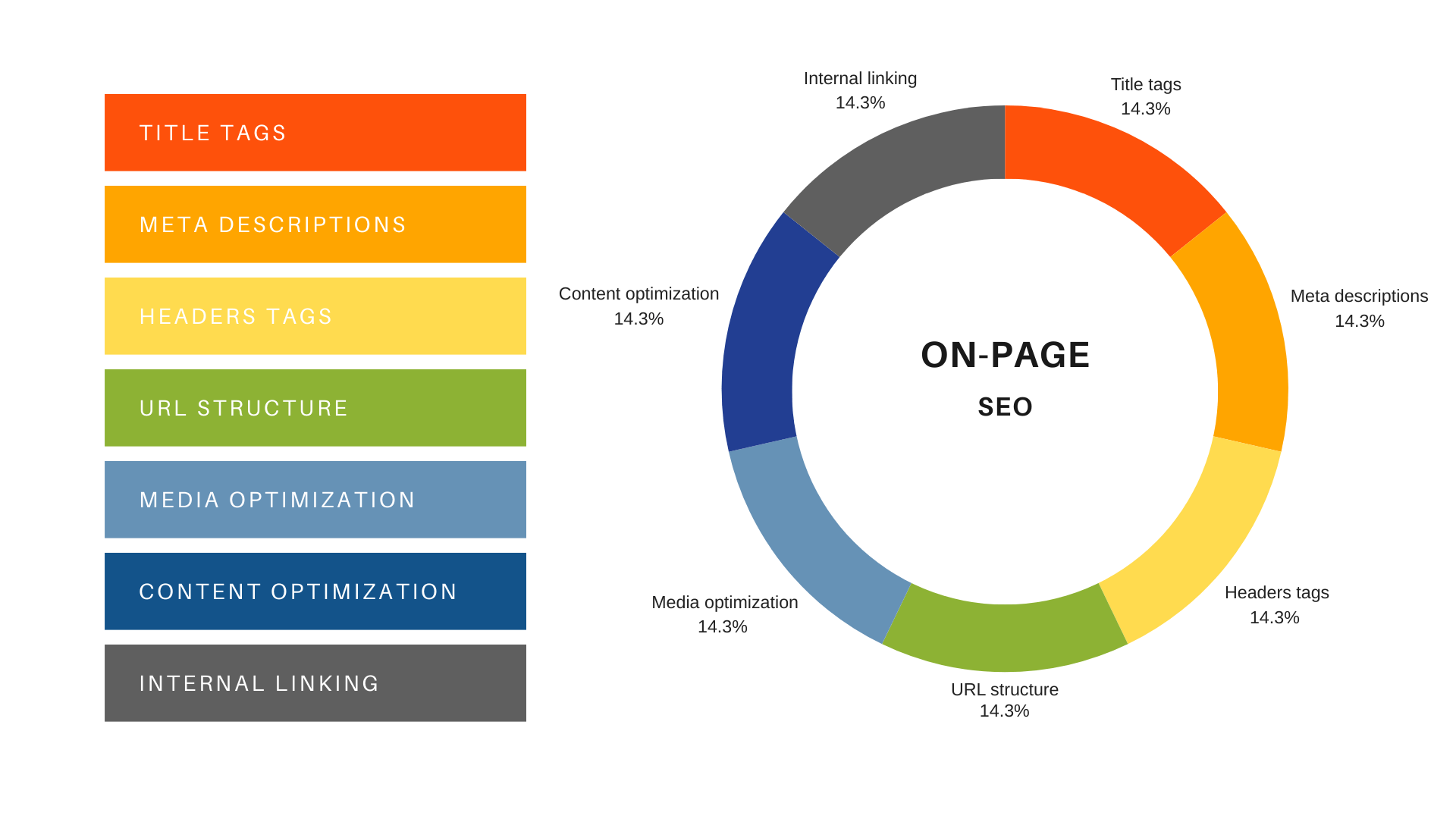
Roofing contractors can think of on-page SEO as everything that can be done to give each website page a distinct competitive advantage. It includes addressing several elements that we’ll get into below. When thoughtfully optimized, these elements contribute to a page’s overall performance in SERPs.
On-Page SEO covers:
Title tags are one of the first things users and search engines see when they find your website. That makes them a powerful tool for improving your roofing business’s on-page SEO. A well-crafted title tag helps search engines understand your page’s primary focus, ensuring it appears in relevant searches like "roof repair services" or "emergency roofing contractor."
Your title tags should be clear and concise and include important keywords specific to your business and location. For example, a title tag like “Reliable Roof Repair in Atlanta | Example Company Name” targets the service you offer (roof repair) and the local area you serve (Atlanta), making it easier for potential customers to find you.
Here’s what that same tag looks like as a line of HTML:

When you add this line of HTML text to your site, it’ll display as the clickable headline in search engine results and help you attract users to your website.
A meta description summarizes your webpage’s content and appears beneath your page title in search engine results. It provides a concise overview of what type of roofing content users can expect to find on your page and helps them decide whether to click through to it. While a meta description technically doesn’t directly impact your SEO rankings, a well-written meta description will increase click-through rates by making your content more appealing and relevant to searchers.
Limit your descriptions to around 150-160 characters, include relevant keywords, and craft them to engage users by addressing their needs or questions.
Here’s an example of what your meta description should look like as a line of HTML:

Header tags add structure to your page, make finding information easier, and break up big blocks of text to add more visual interest, but that’s not all they’re good for. They’re also an on-page SEO component you can use to reach more of your target audience. Header tags, like H1, H2, and H3, structure your content on each page, guiding readers and search engines through key topics.
An H1 tag should include your main keyword, for example, "Roofing Services in Atlanta,” to let search engines know what your page covers. Subsequent header tags (H2, H3) can break down other important topics, like "Roof Repair Services," "Residential and Commercial Roofing," or "Why Is Your Roof Leaking?" helping visitors quickly find what they’re looking for.
Include relevant keywords naturally in these headers to enhance your page’s SEO score while keeping it well-organized and readable.
Yes, nested headings further enhance UX and site crawlability for search engines. You’ll only use the H1 header once, but you’ll use H2s, H3s, and H4s to break down more specific information related to a parent heading.
On a roofing contracting website with nested headings, your HTML could look something like this:
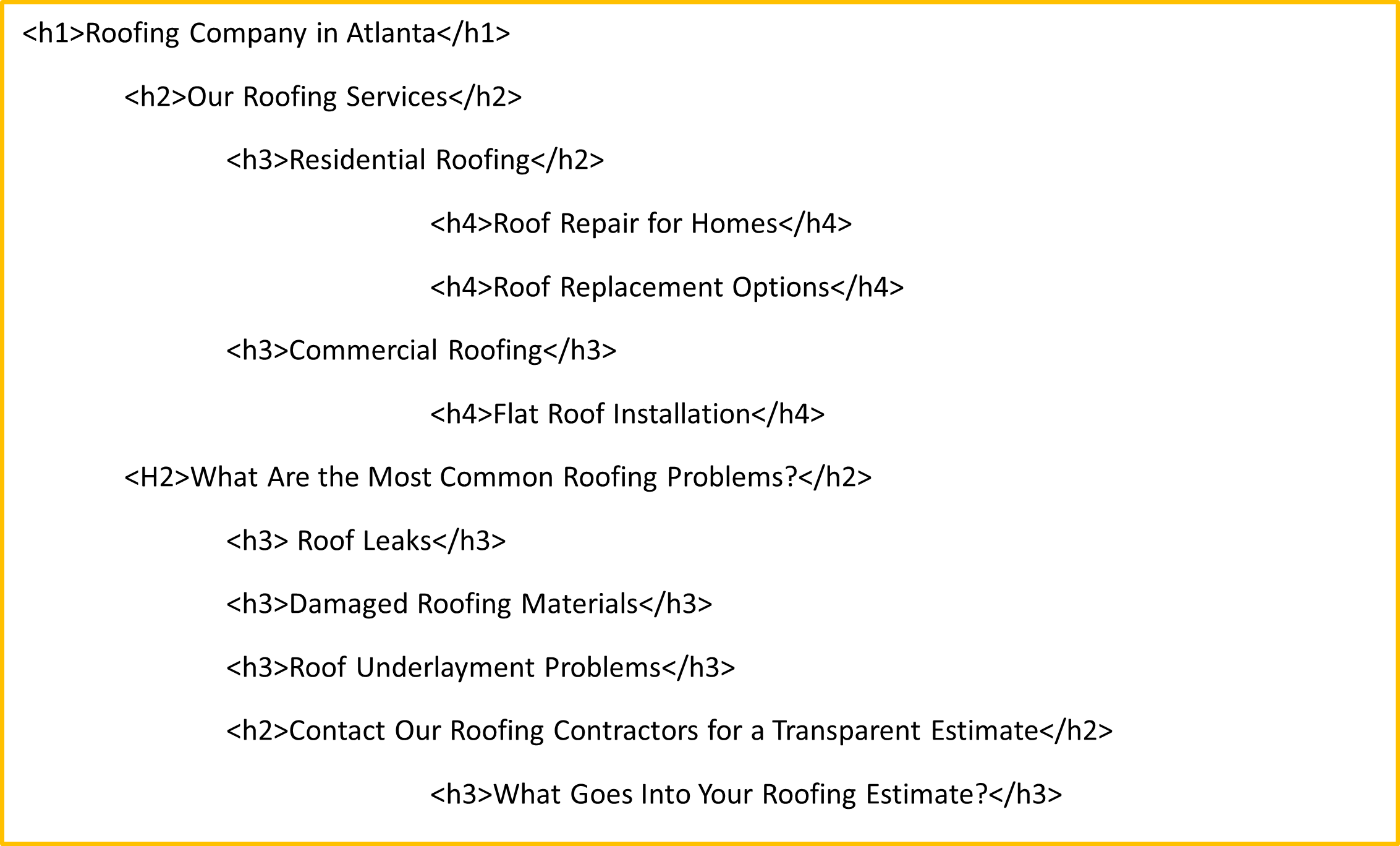
Structuring your roofing website’s URLs thoughtfully is a simple yet powerful way to boost SEO and enhance user experience. Optimizing your roofing site’s URL structure clarifies the hierarchy and relevance of each page, making it easier for search engines to index your content accurately.
Here are some best practices for creating SEO-friendly URLs:
Clean, straightforward URLs help attract more clicks in search results and provide search engines with clear context so they know when your site is the best selection to serve at the top of search results.
Adding photos and graphics to your roofing web pages helps make your content more engaging and attractive. Visual elements like before-and-after photos of roof repairs you’ve completed, infographics on roofing materials you recommend, or diagrams of roof structures you’ve built help visitors understand your services better and stay on your page longer. This visitor behavior tells search engines your content has value.
Each image provides an opportunity to optimize with relevant alt text, file names, and captions, allowing you to include keywords naturally and improve your chances of appearing in image search results. Select high-quality visuals to boost on-page SEO and build trust by sharing your work and expertise with people who want to learn more about what your business is capable of.
Image alt text is a written description you can add to images on any of your roofing service and landing pages. This text helps search engines decipher what the image you included represents and aids users with visual impairments by providing descriptive text for screen readers.
Here are some tips for optimizing image alt text:
People search for images all the time to get a good idea of roofing work. When you want the images you include to be more discoverable in search results, you should start by renaming each photo with descriptive, keyword-rich terms that clearly reflect what the image holds.
Instead of using a generic file name like "IMG_1234.jpg," use something specific like "residential-roof-repair-atlanta.jpg" or "asphalt-shingle-roof-installation.jpg." Use hyphens between words since search engines can read these as separate terms, whereas they may not recognize underscores as spaces.
Avoid using filler words like "and" or "the" in your image file names. Instead, focus on including relevant details like roof types, materials, and location.
Here’s a recap of some SEO-optimized image file names you could use for your roofing site if you’re open for business in Atlanta:

SEO video optimization enhances a video’s visibility in search results by making it easier for search engines to comprehend what’s happening in your video content. This process involves several steps, starting with keyword research to identify the terms people search for that relate to your video’s topic. Skip down to our “content SEO best practices” section and read the instructions under “keyword (KW) research” for more information on how to mine the best roofing keywords and search phrases.
Once you have a solid list of KWs, include them in your video title, description, and tags to help search engines identify your video’s relevance. You should also use an engaging thumbnail to grab people’s attention and add captions or transcripts to improve accessibility and keep viewers captivated. This engagement boosts watch time—a factor that search engines use to gauge your video’s value.
Proper SEO video optimization also involves hosting videos on a fast, reliable platform and embedding them on relevant web pages, which helps drive more traffic. Combining these strategies improves your video’s chances of ranking higher, reaching a broader audience, and driving more engagement on your page.
Search engines and users gravitate towards high-quality, authoritative, and informative content on roofing websites because it builds trust, enhances user experience, and provides valuable answers to common roofing questions. Users want to feel confident they’re getting reliable information, whether they’re researching roofing materials, costs, or maintenance tips.
High-quality content does just that, positioning your website as a knowledgeable source that addresses customer concerns and educates them on important roofing decisions. Search engines also favor content that’s well-researched, relevant, and comprehensive. It indicates your website is a trustworthy source worth ranking highly.
When you create content for your roofer website, focus on providing clear, helpful, and accurate information. This will help enhance your site’s visibility in search results and foster user engagement, turning visitors into potential customers who value your expertise.
We’ll explain more about how to do this and the best practices for writing compelling, evergreen content below, but first, let’s close out this section on the basics of on-page SEO by examining how internal linking strengthens your on-page SEO strategy.
Did you know you can use strategically placed internal links to guide visitors through your website, ensuring they see essential pages? To take full advantage of this on-page SEO technique, you should link related pages within your site.
An example could be connecting a blog post on "Choosing the Right Roofing Material" to your "Roofing Services" page. In creating this pathway between your two pages, you help search engines understand your content’s structure, which can improve your page rankings.
Start by figuring out which pages you want to promote. This could include your service offerings, testimonials, or informative blog posts. Then, within each page, link to relevant content that adds value, like directing users reading about "Roof Repair Tips" to your "Emergency Roof Repair" service page.
Aim to use clear, descriptive anchor text (the clickable text that takes users to the linked page) that naturally includes keywords, helping search engines associate those terms with your services. Don’t forget to regularly review and update your internal links to connect new and existing pages.
When you use internal links to your advantage, you keep your website cohesive and make it easier for visitors to find valuable information.
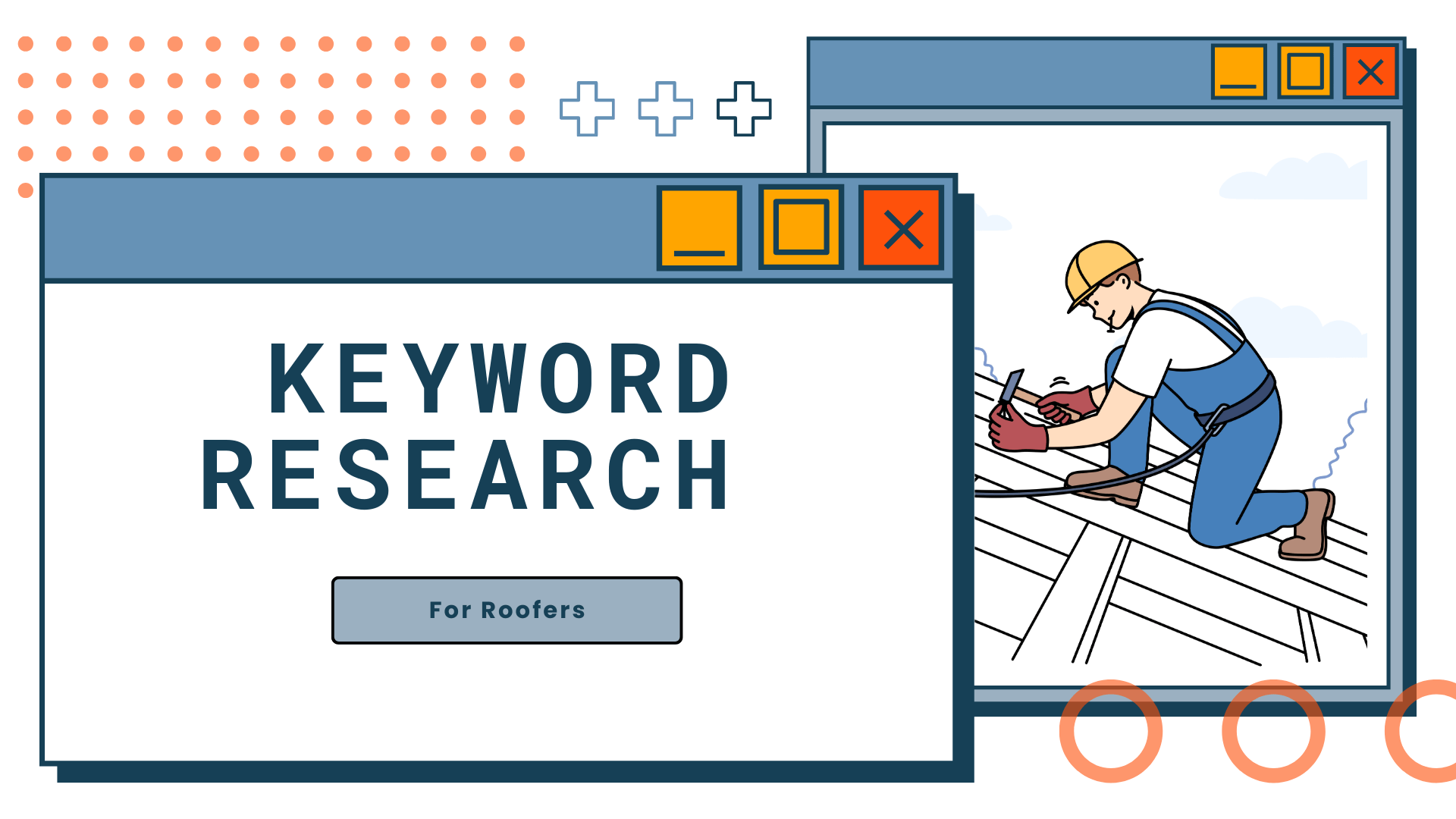
Effective content SEO practices help your roofing website rank higher by aligning your content with what potential customers are actively searching for. Creating content that resonates with people looking for roofing services requires a strategic approach: Focus on high-value keywords, craft engaging blog posts, and ensure every piece of content you create is informative and relevant.
These strategies build authority for your roofing business and attract more qualified traffic. Below, we’ll break down key content SEO techniques, including keyword research, to identify the search terms and phrases potential clients use when looking for roofing services. We’ll also cover the importance of long-tail keywords and answer engine optimization, then recommend tools to help you discover the industry’s most relevant and valuable keywords.
Keywords are the specific words or phrases people type into search engines when they’re looking for roofing information, products, or services. In roofing SEO, relevant keywords are those that directly relate to your industry’s core services, materials, common questions, and specific customer needs.
For example, foundational roofing keywords include phrases like:
In addition to these general keywords, long-tail keywords—like "affordable roofing contractor in [your city]" or "how to fix roof leaks"—are incredibly valuable because they target specific search intents, often reaching highly motivated customers.
Identifying high-value roofing industry keywords starts with understanding what potential customers are likely to search for. Begin by brainstorming common services, materials, and questions related to roofing. Think of terms that customers might use. This could include "roof repair," "roof replacement," or "roofing inspection services."
Expanding on these basics, consider specific types of roofs, materials (like metal or asphalt shingles), and locations. This process helps you create a list of core keywords that cover the essentials of your services and lay the foundation for deeper keyword research.
Once you have a general list, use keyword research tools like Google Keyword Planner, Ahrefs, or SEMrush to refine your keywords and identify their search volume and competition levels. High-value keywords usually balance having a reasonably high search volume and manageable competition.
For instance, “emergency roof repair” or “leak detection roofing service” may have fewer searches than broader terms like "roof repair," but these keywords capture users with an immediate need, making them more likely to convert. These tools can also suggest related phrases and long-tail keywords, which are longer, more specific phrases that more accurately reflect a searcher’s intent.
It also pays to analyze your competition by looking at other high-ranking roofing websites. Check which keywords appear frequently on their pages, especially in headers, subheaders, and blog titles. Pay attention to gaps or specific services they may not fully address. These are opportunities for you to rank higher with unique or specialized content.
Answer engine optimization (AEO) is about creating content that directly answers people’s questions about roofing services, making it easier for search engines to feature your answers. This is especially helpful for voice search and getting your answers highlighted in search results, known as rich snippets. AEO falls under the content SEO pillar, focusing on making your website informative and user-friendly.
We’ve included a question above as an example of AEO in action. If you were searching for “What is answer engine optimization?” on Google, our heading could show up as a featured answer. By structuring content in a question-and-answer format, you’re more likely to attract users who favor voice search and others looking for quick, trustworthy information.
Think about the questions people typically ask when considering roofing services.
If you specialize in new roof installations, consider question keywords like:
Using these kinds of question phrases in your content helps position you as an expert in the roofing industry and makes it easier for search engines to show your answers to people searching for similar topics.
People search online to get fast answers to their questions. When you include the questions potential clients ask in your content (and give direct, clear answers), you show search engines—and customers—that you’re an authority on roofing.
Optimizing for AEO goes beyond just content SEO, involving a few other aspects of SEO:
Words aren’t the only thing that matters when you’re crafting content to reach people who need a new roof. You can also go the extra mile and show them what you’re capable of by adding high-quality images, infographics, videos, audio, downloadable resources, and interactive site elements.
The old saying “the proof is in the pudding” rings true. People want to see examples of your work (photo galleries) and examples of what you know (informational videos about roofing materials, roof maintenance tips, inspection criteria checklists, etc.) so they can make informed decisions about the rooftops on their homes or businesses.
Some examples of what to include on select roofing web pages include:
With effective keywords, content optimized to answer questions, and a variety of helpful, engaging content forms, you now have all the tools you need to create the type of roofing content people want to see and can benefit from when they search for roofing services online.
Off-page SEO includes everything you can do outside your website to attract more visitors. Building high-quality backlinks is one of the most effective strategies since it boosts your site’s authority and visibility in search engine results.
We’ll walk you through how to do this below, but before we do that, let’s look at a checklist of all the elements of a good off-page SEO strategy for roofers:
Backlinks, or inbound links, are links from other websites that point back to your site. They act as votes of confidence that give search engines a heads-up that your content is trustworthy and most likely to be what searchers are looking for. Since backlinks hold a lot of weight online, it’s important to know how and where to secure them to achieve the best results.
Quality matters more than quantity—score links from reputable, high-authority sites related to roofing. Reaching out to respected home improvement blogs, roofing industry publications, or local business directories is an excellent way to generate valuable links to your roofing site.
Be sure to avoid spammy or irrelevant links. These super low-hanging fruits aren’t worth your efforts because they may harm your rankings rather than help them. Building a strategic approach to backlinks can improve your search engine visibility and drive more targeted traffic to your site.
Guest posting—writing articles for other websites—is a strong strategy for earning backlinks while sharing your expertise with a broader audience. Beyond just the links, it’s a fantastic way to build connections within your community and demonstrate to industry leaders, homeowners, and potential clients that you know all there is to know about roofing in your region.
When your insights appear on respected local business sites, industry blogs, or home improvement platforms, it enhances your credibility and increases your business’s visibility. The more positive exposure your roofing business receives from trusted sources, the more you’ll strengthen your reputation and attract new clients.
Some guest post topics you could consider covering include:
Collaborate with other local business owners through guest posting to build your online presence and anchor your backlinks with the weight you need to improve your position in SERPs.
You may have noticed that everyone and their grandma has a social media account these days. That’s because creating a social media presence for your brand is no longer about appealing to a younger audience and proving that you’re still relevant and hip. Now that everyone (and we mean practically everyone) is tuned into social media, you have a bunch of new opportunities to connect with them—more than ever before.
With Facebook, X, Instagram, LinkedIn, and TikTok leading the way and more platforms becoming more popular every day, it can be hard to know where to start when you want to take advantage of online marketing opportunities.
We suggest focusing on mastering one platform at a time and starting with the one the majority of your target customers use. Once you’re on social media, the strategy can vary.
Here are some tips for establishing a social media presence:
Sometimes, in the hustle and bustle of trying to provide the best roofing services, it’s easy to overlook the importance of creating shareable content, like informative guides, blogs, videos, infographics, or case studies that encourage others to link back to your site organically. Content marketing is a goldmine for building your brand and driving traffic.
Roofers can leverage content marketing by writing about topics that address common customer questions, like “Signs You Need a Roof Replacement” or “How to Prevent Roof Leaks.” Users are more likely to share these with others who might find them helpful. Creating location-specific content, like “Roofing Tips for Homes in [City/Region],” can also help capture local search traffic.
Additionally, visual content, including before-and-after photos of your roofing projects, infographics on materials, or even short explainer videos and podcasts, can help engage viewers and provide you and other users with something to share.
When you focus on creating valuable, shareable content that you can broadcast across all channels, you unify your message, increase your domain authority, and set your business apart from competitor roofing companies.to customer satisfaction, which will foster trust and encourage new clients to choose your services.
Search engines like Google consider customer reviews a sign of credibility and relevance, which can help improve your local ranking, even though these reviews are off-page away from your website. The good part is that you can import these reviews and attach them to your page to provide fresh, user-generated content that often includes keywords (like “roof repair” or “roof replacement”) associated with your business. These keywords in your online reviews can help enhance your visibility in search results and help your company win the hearts and favor of new clients.
Think of it this way: The only thing better than being able to tell your potential clients what you’re capable of is when one of your previous paying clients is so delighted with the quality and longevity of your roofing services that they do it for you.
Taking the time to respond to positive or negative reviews also demonstrates excellent customer service and supports your reputation management efforts. Responding shows potential clients that you value feedback and are committed to customer satisfaction, which will foster trust and encourage new clients to choose your services.
The best places for roofers to manage and encourage reviews include:
Cultivating positive reviews across these platforms can substantially impact your business’s reputation and online presence.
Brand mentions are when your roofing business name or services are referenced on other websites, even if there’s no direct link back to your site. These mentions help build your brand’s authority and visibility since search engines like Google recognize them as signals of credibility and relevance.
For example, if a local real estate blog mentions your roofing expertise or a supplier includes your company as a trusted contractor, it enhances your business’s online reputation. Find ways to secure mentions on reputable sites—like industry blogs, local directories, and review platforms—to increase brand awareness and foster trust among potential customers.
Encouraging positive mentions on social media or in industry publications can further boost your search engine ranking, helping your roofing business capture more attention online.
For roofing contractors, engaging in online forums and local community groups can be an effective way to connect with potential customers searching for roofing services. Your participation in forums like Reddit, Quora, or industry-specific sites allows you to answer common roofing questions, share expert advice, and provide helpful information that demonstrates your knowledge. This engagement builds credibility and trust, positioning you as a go-to expert for people researching roofing options or needing help with repairs or installations.
Additionally, joining community groups on social media platforms, like local Facebook groups, allows you to engage directly with homeowners in your area who may be seeking recommendations or advice.
Sharing insights on topics like roofing maintenance, seasonal preparations, or material comparisons helps you establish your expertise and keeps your business top of mind for local residents. These strategies build relationships and trust, which naturally lead to more referrals and inquiries as people come to recognize you as a valuable resource in the roofing industry.
Overall, the goal of off-page SEO is to generate leads and customers by establishing yourself as a trusted authority within the community. Whether it’s backlinks, guest posting, social media, reviews, or community engagement, these strategies help accomplish that goal.
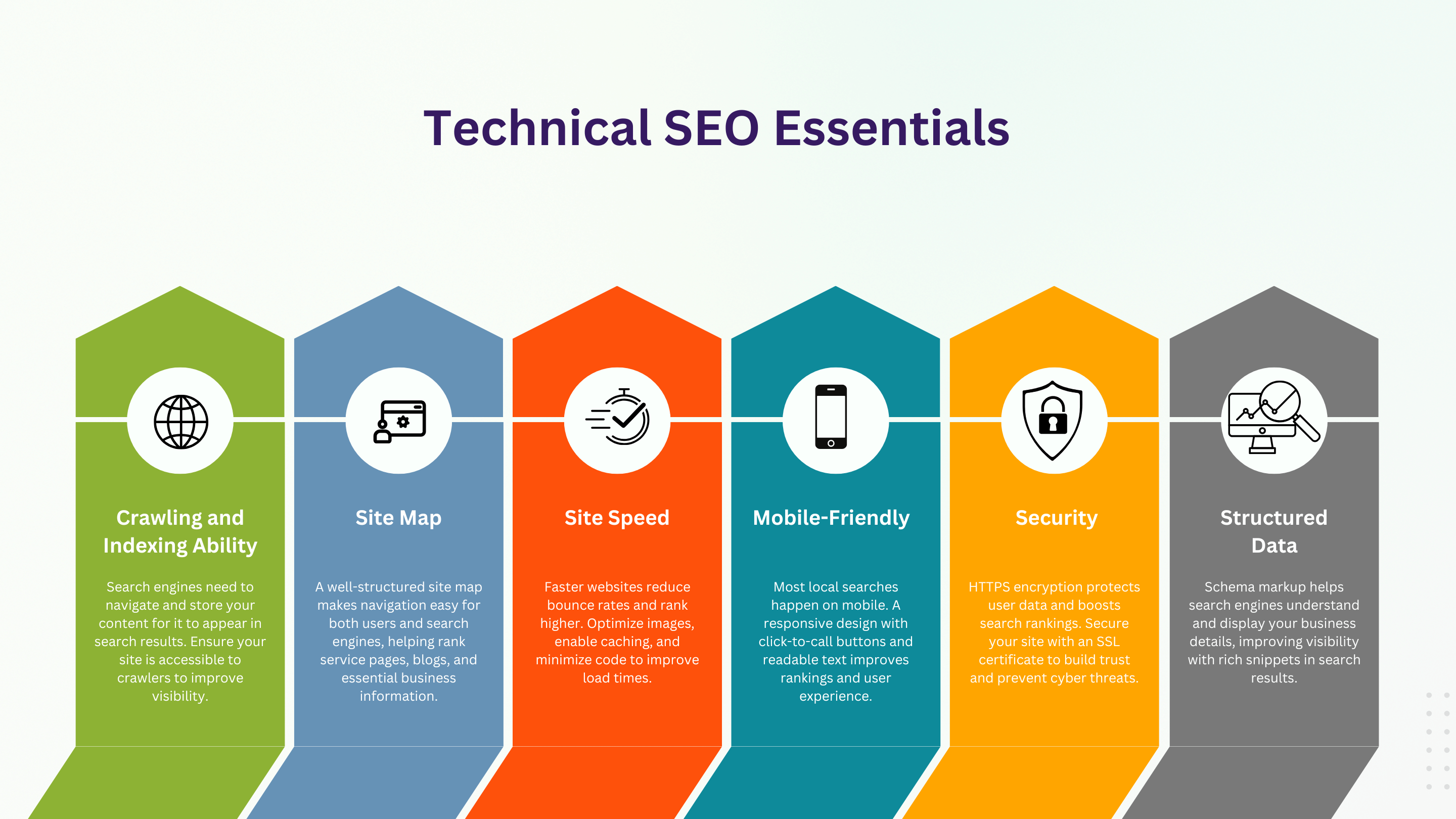
Technical SEO refers to optimizing your website’s behind-the-scenes elements to make it more accessible, faster, and easier for search engines to understand and rank. It improves aspects like site speed, mobile-friendliness, secure connections (HTTPS), crawlability, and structured data to ensure your website is technically sound and aligns with search engine guidelines.
When you focus on improving your site’s technical SEO, you make it easier for search engines to index your website accurately, which boosts your chances of appearing in relevant search results. For a roofing business, implementing strong technical SEO helps you capture more online traffic by making sure your website loads quickly, is easy to navigate on mobile devices, and presents clear, well-organized information about your services.
These enhancements improve search rankings and create a positive user experience, which keeps visitors engaged and increases the likelihood they’ll contact you for roofing services.
Before we discuss how to build a proper site map and optimize your site speed, it’s important to understand how search engines crawl and index pages on your website so you can see how it all comes together. We’ll break this down below.
Crawling and indexing are foundational components of technical SEO that help roofers get discovered online. Crawling is the process where search engine bots, or "crawlers," navigate through websites, analyzing each page to gather information.
Indexing happens after crawling. It’s when search engines store and organize this information so your content can appear in relevant search results. Ensuring your site is accessible for crawlers to navigate is essential to getting your pages indexed and ranking well.
When your website isn’t optimized for crawling and indexing, even high-quality content might go unnoticed by search engines, making it harder to reach your target audience. Turn your attention to optimizing SEO elements to ensure your roofing services are visible to more potential customers searching for solutions online.
Building a site map for your roofing website involves organizing information to be user-friendly and SEO-optimized. This process ensures potential customers can easily find services and resources. Start with a clear, concise homepage highlighting essential services like residential roofing, commercial roofing, repairs, replacements, and inspections. Each main service should have its own dedicated page, providing detailed information to improve search engine rankings and guide users to precisely what they need.
Include a “Services” section with subpages for specific offerings, like metal roofing, shingle installation, and emergency repairs, so visitors can explore options without feeling overwhelmed. Adding a “Projects” or “Portfolio” section with examples of past work builds credibility, and a “Testimonials” page reinforces customer trust.
Don’t forget an “About Us” page to introduce your company and a “Contact” page featuring a clear call to action, contact form, phone number, and physical location, if applicable. A “Blog” section with regular posts on roofing maintenance tips, seasonal roofing advice, and common roofing questions helps educate visitors and boosts your site’s SEO score.
Make sure your site map is easy for search engines to crawl by submitting it to search engines like Google and including simple navigation tools for users to move between pages quickly. Following these best practices will create an intuitive, SEO-friendly roofing website that helps visitors find information quickly and boosts online visibility.
Would you still be here if this page had taken forever to load? Would you have made it this far through our article, or would you have bounced away to try to find this information elsewhere, even though there’s still a substantial amount of easy-to-implement SEO advice below? Now that you see the value of a swift load speed, you need to know how to improve yours.
You can begin by compressing image files and using next-gen formats like WebP, which maintain quality with smaller file sizes to reduce loading time. Another way to speed up your website is to implement browser caching and enable lazy loading for images and videos so that only content in the user’s view loads immediately, while the rest loads as they scroll. Reducing HTTP requests by combining CSS, JavaScript, and HTML files into fewer files is another step you can take to minimize your site’s loading time.
Audit your website for any unnecessary plugins or scripts that can slow performance, and consider implementing server-side rendering for dynamic content. Regularly monitor your site’s speed with tools like Google PageSpeed Insights to catch and address any new issues.
Site speed is the secret to creating a smoother, more responsive experience that search engines favor and users appreciate, so you don’t want to overlook this essential element of technical SEO.
Optimizing for mobile-friendliness is necessary for your roofing business’s technical SEO strategy since more potential customers search for local services on their smartphones. Making sure your website is fully responsive means it automatically adjusts to fit various screen sizes, providing an intuitive, easy-to-navigate experience on mobile devices.
A mobile-friendly roofer website has buttons and contact forms that are easily clickable, text that’s readable without zooming, and website images that load quickly. Mobile-optimized sites rank higher on search engines because Google and other engines prioritize mobile usability in their ranking algorithms.
This is especially important to note since mobile users often look for immediate, local information—like contact details, service descriptions, and reviews—while on the go. Implementing mobile-friendly design elements like click-to-call buttons and interactive maps can directly improve conversions by making it easy for users to reach out.
When you want more qualified leads, don’t overlook the value of optimizing for potential clients who use their mobile phones and tablets to learn more about local roofing services.
Website security is an important issue, more so now than ever. With online security threats on the rise, protecting your site, data, and clients from potential breaches and attacks requires proactive steps. Implementing HyperText Transfer Protocol Secure (HTTP) protocols is fundamental in securing your website and building trust with your visitors.
HTTPS encrypts the data exchanged between your website and users’ browsers, safeguarding sensitive information like passwords, personal details, and payment data from prying eyes. Moving from HTTP to HTTPS requires a Secure Socket Layer (SSL) certificate, which you can obtain from a trusted certificate authority. Besides enhancing security, HTTPS is also a ranking factor for search engines like Google, meaning that secure websites are more likely to appear higher in search results.
Attracting qualified leads involves making your roofing website easy for search engines to understand and display so that more people can see what you do and what your business is all about. Structured data, or schema markup, is a type of code you can add to your website that provides search engines with detailed information about your business and services. For a roofing website, implementing structured data can make essential details like your business name, location, services, reviews, and contact information appear prominently in search results as rich snippets.
Adding schema markup to your website may sound complicated, but it’s simpler than you think and will significantly boost your search visibility. Schema is just extra code you add to specific pages on your site to help search engines understand your business.
Here’s a step-by-step breakdown to make it easier:
Structured data helps search engines show your roofing services clearly to potential customers. It’s a small investment in code that greatly impacts search visibility and user engagement.
No, you don’t need schema on every page—just on pages that include the information you add. For example, add business details on the homepage or contact page, service details on each service page, and reviews on a testimonials page.
A rich snippet is an enhanced search result that displays extra information beyond the standard title, URL, and meta description, making your listing stand out in search results. Rich snippets can include elements like star ratings, product prices, images, and specific details like your business hours or customer reviews. These enhanced features give users a quick glimpse of relevant information, helping them better decide if your website meets their needs before clicking. Being featured in a rich snippet also adds credibility to your business—the search engine chose yours, after all—and prominently displays your site near the top of the page.
For example, a roofing website with structured data might display a snippet featuring services, service ratings, and average costs, making it more appealing to potential customers. Leverage rich snippets to make your website more visually informative and compelling in search results.
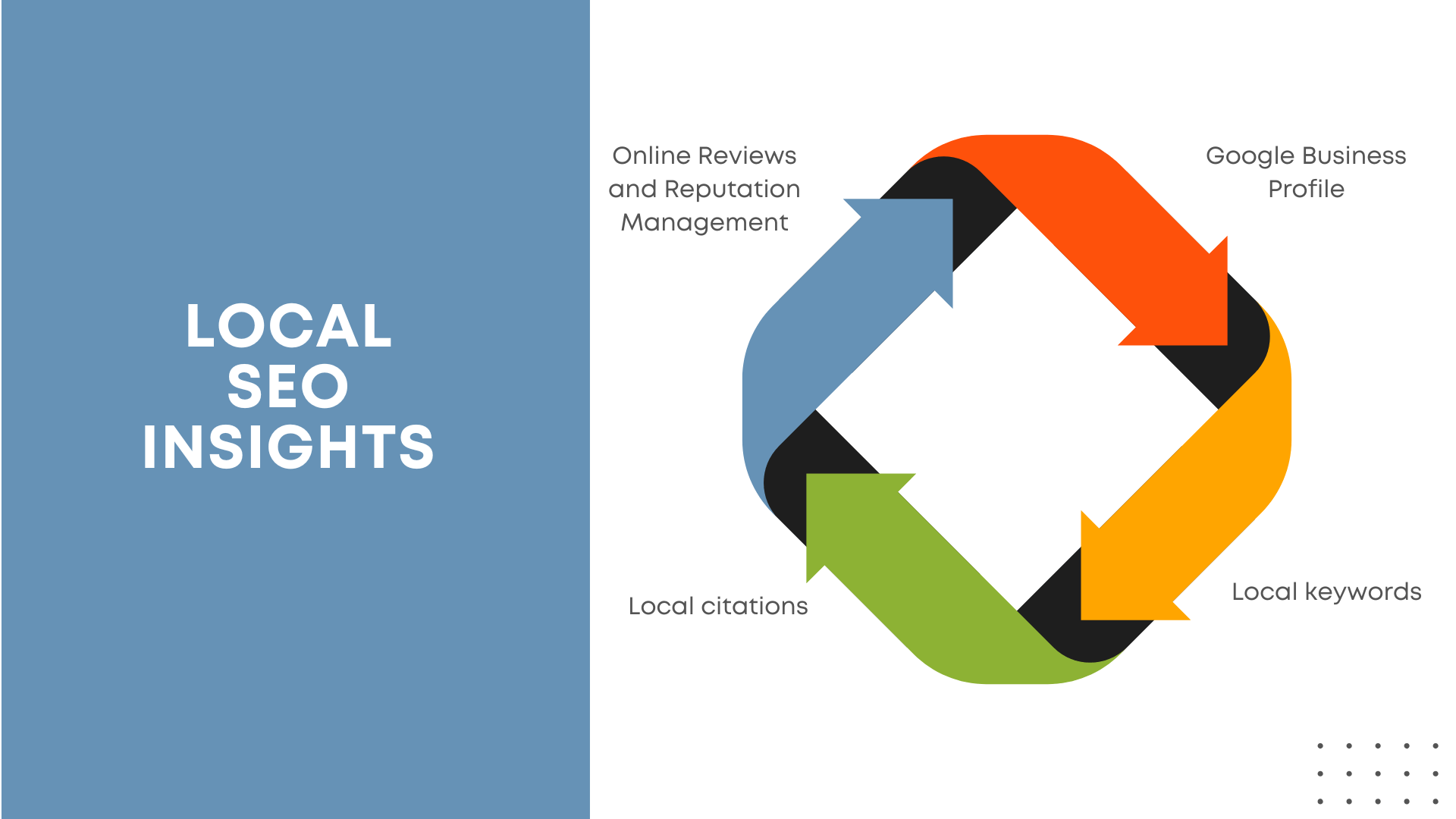
Local SEO involves optimizing your website to increase visibility for users searching within your service area. For a roofing business, this means showing up in searches like “roofing company near me” or “roof repair in [city].” Key local SEO tactics include using targeted keywords, gathering customer reviews, and ensuring consistent contact information. Optimizing your Google Business Profile (GBP) is also essential since it helps your business appear in Google’s local results, like Maps and local packs, driving qualified leads directly to you.
Your Google Business Profile (GBP) is a free tool for managing how your business appears on Google’s Search and Maps. For roofing companies, an optimized GBP is often a customer’s first look at your services when searching locally. Profiles show critical information like business hours, contact info, location, and reviews, making it easier for potential clients to reach you.
An active, well-maintained GBP boosts your local SEO efforts, connects you to nearby clients, and reinforces your credibility through positive customer feedback.
Here’s what ours looks like. 
We talked about keywords and how to mine relevant and related search terms above, but now it’s time to dial in on what local keywords are and how to use them.
Local keywords are search terms that include specific geographic locations, like city names, neighborhoods, or phrases like “near me.”
For your roofing business, local keywords that move the needle for you might include terms like “roofing installation in [city]” or “residential roofing contractor near [neighborhood].”
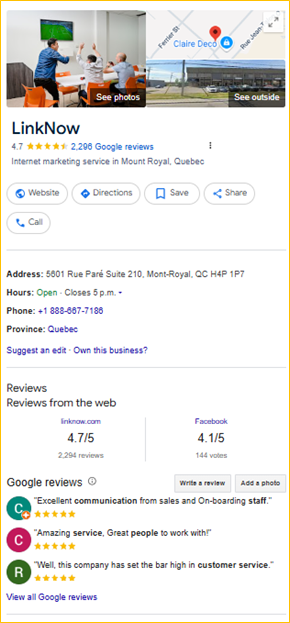
These keywords help your website appear in searches from users in your area looking for the exact services you provide. To effectively use local keywords, incorporate them naturally throughout your website content, including on service pages, blog posts, meta descriptions, and headers. This practice will signal to search engines that your roofing company is active in your area.
Pro tip: Don’t miss out on your chance to include relevant local keywords in your Google Business Profile, where they can further boost your visibility in local search results.
Whenever your business’s essential details, like your company name, address, and phone number (NAP), are mentioned online, such as in websites, directories, or social platforms, this is considered a local citation. For a roofing contracting company, these citations appear on platforms like Google Business Profile, Yelp, Yellow Pages, and industry-specific directories.
Local citations come into play in local SEO by building credibility and increasing visibility in search engines, particularly in local search results. Consistent and accurate citations help search engines verify your business’s legitimacy and location, making it more likely to appear when potential customers search for roofing services in your area.
Maintaining up-to-date citations across various websites improves your search rankings and helps usher more potential clients to your site.
NAP consistency is important because it can significantly impact your local SEO ranking and your business’s credibility with search engines and customers. Having the same information listed across all online platforms, including your website, Google Business Profile, social media, and local directories, tell search engines like Google that they can confidently identify and rank your business accurately in local search results.
Inconsistent information, on the other hand, can lead to confusion, potentially lowering your search ranking and making it harder for customers to find and trust your business. Keep your NAP details up-to-date and uniform across all listings to maintain a strong online presence.
Positive reviews tell search engines that your business is reliable and popular, making it more likely to appear higher in local search results. For your roofing business, a steady stream of high-quality reviews on platforms like Google, Yelp, and industry-specific directories helps enhance visibility. It serves as social proof, encouraging potential customers to choose your services.
Reputation management involves actively responding to the reviews people leave about your company, whether positive or negative. When you take the time to do this, you show engagement, professionalism, and a commitment to your customers’ satisfaction.
Addressing negative feedback constructively can improve customer perceptions and turn a poor experience into a positive one. Search engines reward active businesses with high engagement, so investing in online reviews and reputation management is a smart way to boost local SEO and attract more clients.
Ultimately, roofing is a local business, meaning you need to be visible to a local audience. Your GBP, local keywords, and citation and review management will put you in front of local users searching for a roofer who can solve their needs.
There are many metrics you can pay attention to when you want your roofing website to secure a higher rank in SERPs. Regularly monitoring metrics like organic traffic, bounce rate, and keyword rankings helps you gain valuable insights into how users interact with your site and which pages attract the most engagement.
Analytics tools like Google Analytics and Google Search Console allow you to track the effectiveness of targeted keywords, local SEO efforts, and content performance. For instance, you can identify which of your blog posts or service pages drive traffic and conversions, then build on those topics with fresh content or optimized calls-to-action.
Tracking performance also helps you spot and address issues, like slow page load times or high bounce rates, which can negatively impact your SEO ranking. When you continuously analyze and adjust your SEO strategy based on real-time data, you can make informed improvements that boost visibility, attract more qualified leads, and give your roofing company a competitive edge in local search results.
To monitor your SEO performance effectively, focus on key metrics supporting your specific goals, like organic traffic, keyword rankings, click-through rate (CTR), bounce rate, and conversions. Organic traffic measures the number of visitors finding your site through search engines, while keyword rankings reveal where your pages rank for specific search terms, showing how well you’re reaching your audience.
Setting initial baselines for each metric will help you track progress over time. For instance, you might aim to increase organic traffic by a certain percentage each month or improve your bounce rate by refining content on high-exit pages. Specialized tools like Ahrefs and SEMrush allow you to dig deeper into your keyword rankings, compare your performance with competitors, and discover new keyword opportunities.
CTR, which indicates how often users click on your link in search results, reflects how compelling your listings are. On the other hand, bounce rate and session duration provide insight into how engaging and relevant your content is. They show you how long visitors stay on your site and whether they explore further.
SEO requires regular review and adaptation, so analyzing these metrics monthly or quarterly is helpful. Use what you learn to make data-driven adjustments. This could include updating content, improving page load speeds, or refining your keyword targeting. Focusing on the metrics for individual pages helps you understand which content resonates most with users. By prioritizing high-performing topics, formats, or keywords, you can create a targeted strategy that attracts more traffic and strengthens your online presence.
Awareness of the most common SEO mistakes that roofers make will help you avoid a lot of headaches. You don’t have to reinvent the wheel, but learning from others’ missteps can save you time and effort while boosting your SEO results.
Here’s what to avoid:
The good news (and you’ve probably already guessed it) is that this page covers all the solutions to these problems, so you can scroll up and revisit the relevant section for more in-depth instructions whenever you need to.
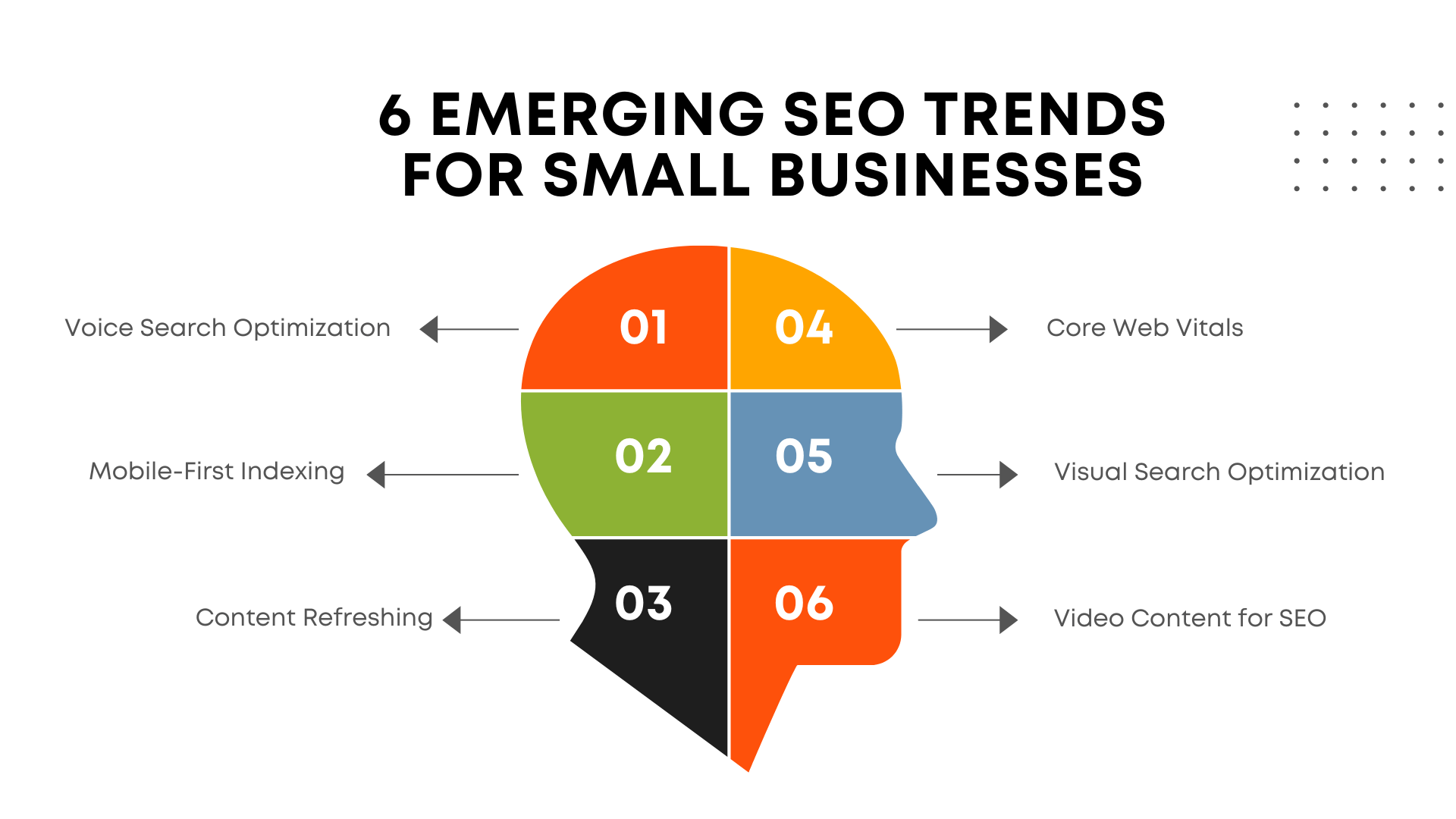
As SEO trends continue to evolve, staying ahead of the curve is how you can maintain your roofing company’s online visibility. Key areas to focus on include optimizing for voice search since more users rely on smart devices for hands-free queries. You’ll also want to make sure your site is mobile-first since search engines prioritize mobile-friendly content now more than ever before.
Other things you’ll want to pay attention to include refreshing your existing content to keep it relevant and competitive and keeping your finger on the pulse of your core web vitals to ensure your site provides a fast, rewarding user experience. Visual search and video content are also on the rise, offering new ways to engage your audience and drive traffic through creative, visually appealing strategies.
Adapt to these trends early, and your business can remain competitive in a rapidly changing and competitive roofing industry.
Here’s how to get it done.
Voice search optimization is when you tailor your website’s content and structure to match how people naturally speak when using voice-enabled devices like smartphones, smart speakers, or virtual assistants. Unlike traditional typed queries, voice searches tend to be conversational and longer, often phrased as questions.
Adapting to this SEO trend is essential because voice search is rapidly growing in popularity, with users expecting fast, accurate answers to their queries. To optimize for voice search, target long-tail keywords, focus on local SEO, and create content that answers common questions. That’s how you increase your chances of appearing in featured snippets and achieving a favorable position on search engine results pages (SERPs).
Mobile-first indexing is reshaping the SERP landscape by prioritizing websites that deliver an excellent mobile experience. Since most searches now happen on mobile devices, search engines like Google have begun to evaluate your site’s mobile version first when determining rankings. This shift means a poorly optimized mobile site can significantly hurt your visibility, even if your desktop version is well-designed.
For a roofing contracting company, optimizing for mobile-first indexing involves ensuring your site is responsive, loads quickly, and displays all content and navigation elements on smaller screens. Including mobile-friendly features like click-to-call buttons, location-based services, and concise, easy-to-read content can also enhance user experience and boost rankings.
Content refreshing involves updating and improving your existing website content to keep it relevant, accurate, and engaging for your audience. For a roofing website, this means revisiting blog posts, service pages, or FAQs to add new insights, update statistics, or align with the latest SEO best practices. Evergreen content—like guides on roof maintenance, common roofing issues, or choosing the right materials—has lasting value because it remains relevant over time.
Periodically refresh this type of content to ensure it performs well in search rankings, provides consistent traffic, and establishes your expertise. For roofing businesses, refreshed, evergreen content builds trust with potential clients and keeps your site competitive in a constantly evolving digital space.
Core Web Vitals is a set of metrics Google uses to measure the user experience on your website, focusing on three key areas:
These metrics assess how quickly your site loads, how responsive it is, and how visually stable it remains during use. Optimizing Core Web Vitals is essential for improving your website’s search rankings since Google prioritizes sites that offer a positive user experience. This means ensuring your site loads quickly with optimized images, has intuitive navigation, and avoids shifting elements that frustrate users. By meeting Core Web Vitals standards, you enhance your position in SERPs and create a better browsing experience that builds trust and keeps potential customers engaged.
Seeing is believing, and visual search optimization takes this to heart, catering to users who search for roofer services using images rather than text. It involves tailoring your website’s pictures and visual content to be easily recognized and indexed by search engines.
To dominate visual search, leverage high-quality photos of your completed projects, roofing materials, and before-and-after transformations. Don’t forget to optimize these images with descriptive file names, alt text, and structured data, as we talked about in earlier sections. When you do this, you help search engines understand the relevance of images on your website and where to place them in image search results.
Did you know that appearing in visual search results on platforms like Google Lens can attract users looking for roofing styles or solutions visually? Harnessing this technique highlights your expertise, making it easier for potential customers to find and connect with your services.
Optimizing video content on your roofing site is becoming an essential SEO strategy as video continues to dominate online engagement. Search engines prioritize rich multimedia content because it captures users’ attention and keeps them on your site longer—two keys in determining rankings. For a roofing business, video content like tutorials, project walkthroughs, customer testimonials, and maintenance tips can demonstrate your expertise while answering common questions.
Optimize your videos with relevant keywords, detailed descriptions, and transcripts to increase their visibility in search results, including on video-specific platforms like YouTube. This helps you attract more traffic and build credibility with potential customers who prefer visual content to understand your services.
Emerging trends like voice search optimization, mobile-first indexing, and visual and video search strategies highlight the evolving ways customers engage with online content. Staying ahead of these trends ensures your roofing company ranks higher in search results and connects with the right audience at the right time, turning traffic into leads and, ultimately, into loyal customers.
You’re here because you want to amplify your roofing website’s online presence. With the ever-increasing number of people searching for roofing services online, it’s clear that leveraging SEO is no longer optional—it’s essential. By focusing on the core principles of SEO, like user experience, content optimization, technical enhancements, and local SEO, you can position your business as a leader in your industry. With a comprehensive, data-driven SEO strategy, your business can rise to the top of SERPs and maintain a competitive edge in a crowded marketplace.
Do you need help creating a personalized SEO plan? LinkNow Media’s web development, UX, and content specialists are here to guide you. Contact us at 1 888-667-7186.